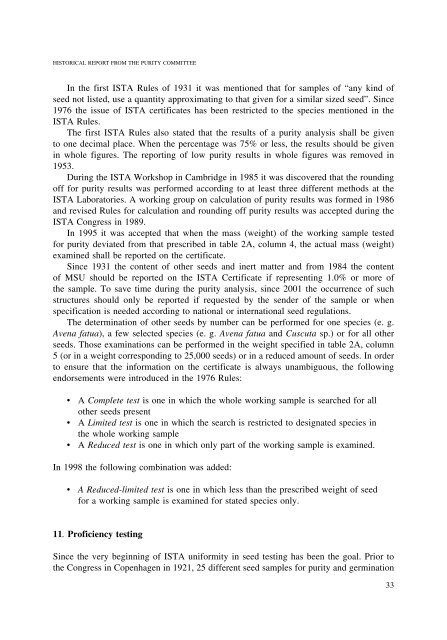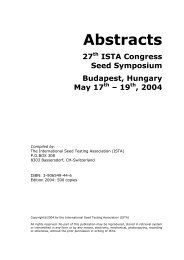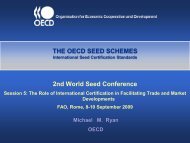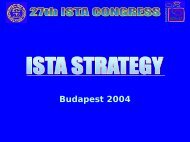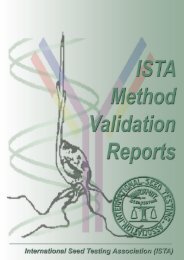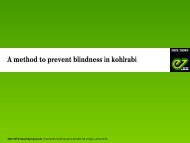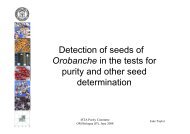Historical Paper - Volume 2 2008 - International Seed Testing ...
Historical Paper - Volume 2 2008 - International Seed Testing ...
Historical Paper - Volume 2 2008 - International Seed Testing ...
You also want an ePaper? Increase the reach of your titles
YUMPU automatically turns print PDFs into web optimized ePapers that Google loves.
HISTORICAL REPORT FROM THE PURITY COMMITTEE<br />
In the first ISTA Rules of 1931 it was mentioned that for samples of “any kind of<br />
seed not listed, use a quantity approximating to that given for a similar sized seed”. Since<br />
1976 the issue of ISTA certificates has been restricted to the species mentioned in the<br />
ISTA Rules.<br />
The first ISTA Rules also stated that the results of a purity analysis shall be given<br />
to one decimal place. When the percentage was 75% or less, the results should be given<br />
in whole figures. The reporting of low purity results in whole figures was removed in<br />
1953.<br />
During the ISTA Workshop in Cambridge in 1985 it was discovered that the rounding<br />
off for purity results was performed according to at least three different methods at the<br />
ISTA Laboratories. A working group on calculation of purity results was formed in 1986<br />
and revised Rules for calculation and rounding off purity results was accepted during the<br />
ISTA Congress in 1989.<br />
In 1995 it was accepted that when the mass (weight) of the working sample tested<br />
for purity deviated from that prescribed in table 2A, column 4, the actual mass (weight)<br />
examined shall be reported on the certificate.<br />
Since 1931 the content of other seeds and inert matter and from 1984 the content<br />
of MSU should be reported on the ISTA Certificate if representing 1.0% or more of<br />
the sample. To save time during the purity analysis, since 2001 the occurrence of such<br />
structures should only be reported if requested by the sender of the sample or when<br />
specification is needed according to national or international seed regulations.<br />
The determination of other seeds by number can be performed for one species (e. g.<br />
Avena fatua), a few selected species (e. g. Avena fatua and Cuscuta sp.) or for all other<br />
seeds. Those examinations can be performed in the weight specified in table 2A, column<br />
5 (or in a weight corresponding to 25,000 seeds) or in a reduced amount of seeds. In order<br />
to ensure that the information on the certificate is always unambiguous, the following<br />
endorsements were introduced in the 1976 Rules:<br />
• A Complete test is one in which the whole working sample is searched for all<br />
other seeds present<br />
• A Limited test is one in which the search is restricted to designated species in<br />
the whole working sample<br />
• A Reduced test is one in which only part of the working sample is examined.<br />
In 1998 the following combination was added:<br />
• A Reduced-limited test is one in which less than the prescribed weight of seed<br />
for a working sample is examined for stated species only.<br />
11. Proficiency testing<br />
Since the very beginning of ISTA uniformity in seed testing has been the goal. Prior to<br />
the Congress in Copenhagen in 1921, 25 different seed samples for purity and germination<br />
33


